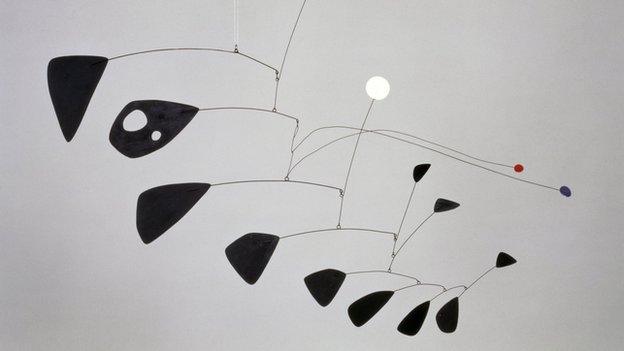Visitors will keep Alexander Calder mobiles on the move at Tate show
- Published

Calder's Antennae with Red and Blue Dots (1953) will feature among the exhibits
Visitors to an exhibition of mobiles by artist Alexander Calder will have a crucial role in bringing them to life.
Curators say the movement of people around the show will create the airflows necessary to make Calder's "kinetic sculptures" rotate.
The exhibition, Alexander Calder: Performing Sculpture, opens at London's Tate Modern on 11 November.
It is billed as "the most comprehensive exhibition" of the American artist's work ever to be held in the UK.
Tate's director of exhibitions, Achim Borchardt-Hume, said: "We thought it time to look at Calder as a serious artist again."
The show will bring together approximately 100 works to reveal how Calder (1898-1976) changed the idea that sculpture was a static object into something that could be continually changing.
"Historically, sculpture was a solid object that you had to walk around to experience in three dimensions," said Borchardt-Hume at Monday's launch event.
"Calder turned this upside down. He makes sculpture move. We no longer move around it - it moves for us."
Calder initially trained as an engineer before studying painting in New York. He travelled to Paris in the 1920s where he developed his wire sculptures and, by 1931, had invented the mobile - a term first coined by Marcel Duchamp to describe Calder's motorised works.

Black Widow (1948) has hung at the Instituto de Arquitetos do Brasil in Sao Paulo for more than 50 years
After 1932, Calder worked mainly on suspended sculptures that moved without motors, animated by air currents.
Asked about air currents within Tate Modern, Borchardt-Hume told the BBC: "There should be enough visitor flow to keep them moving gently."
The gallery's air conditioning may also help, but visitors won't be able to touch the mobiles to set them in motion.
"It'll be a bit like watching the clouds drifting across the sky," added curator Ann Coxon. "These sculptures really invite you to slow down. The movement is going to be subtle and drifting."
The largest work on display will be Calder's Black Widow (1948), which is being shown for the first time outside Brazil.
The monumental piece, measuring 3.5 metres by 2 metres, features 19 black metal shapes delicately suspended from one another.
It was gifted by Calder to the Instituto dos Arquitetos do Brasil (IAB) and has hung in their Sao Paulo offices for more than 50 years. Made in the post-war years, the work is regarded as a visual metaphor for a new and free social order.
It is undergoing conservation work at the Calder Foundation in New York before being moved to Tate Modern.
Alexander Calder: Performing Sculpture is at Tate Modern from 11 November 2015 to 3 April 2016.